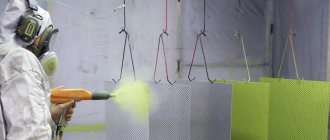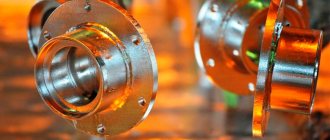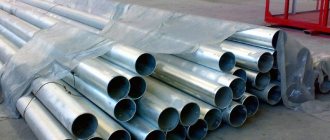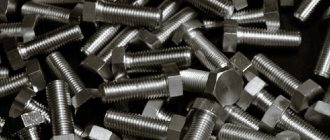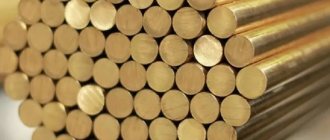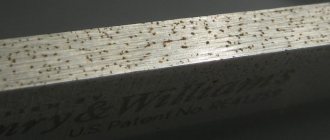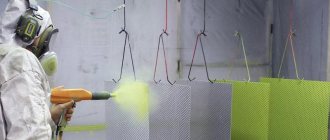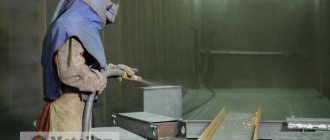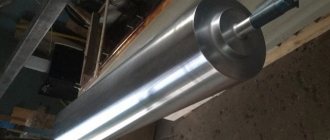A profile sheet with a polymer layer is a durable material, the service life of which can be more than 50 years. In combination with increased load-bearing capacity and low price, corrugated sheets become a reliable building material. The durability of the polymer coating is ensured by the use of advanced technologies - a couple of decades ago there was only galvanized corrugated sheet, the service life of which was 25-30 years. If you apply coatings to galvanized sheets, this will increase the service life by 2 times.
Polyester coating (PE) is applied to increase the service life of metal structures and surfaces and enhance their characteristics, for example, corrosion resistance. This is a combination of polymers, color pigments and other additives that can protect the metal from negative external influences.
What's the point?
To improve the performance properties of the metal, polymers are used that can react under certain conditions. Such coatings are dry compositions based on finely dispersed powder, to which hardeners, fillers and pigments are additionally added. It was not by chance that the polymer coating was chosen to increase the protective properties of the metal: metals conduct electric current, as a result, the charge is transferred to the product, resulting in the formation of an electrostatic field. It attracts powder particles, holding them on the surface of the workpiece. The peculiarity of the polymer coating is its high degree of resistance to any type of impact. Moreover, it is aesthetically pleasing.
Polyester coatings, application, stability, chemical resistance of polyesters
| Aviation fuel, Gasoline Aviation | Stable | Unstable |
| Automotive gasoline, Gasoline, Auto | Stable | Unstable |
| Nitric acid 0-5%, Nitric Acid 0-5% | Stable | Stable |
| Barium Acetate | Unstable | Unstable |
| Sodium Acetate | Stable | Unstable |
| Lead Acetate | Stable | Max. at t = 160 oF (71.111 oC) |
| White liquor - pulp and paper, White Liquor - Pulp Mill | Stable | Unstable |
| Benzyl alcohol | Unstable | Unstable |
| Benzoic Acid | Stable | Unstable |
| Sodium Benzoate | Stable | Unstable |
| Ammonium Bicarbonate | Stable | Unstable |
| Potassium Bicarbonate, Potassium Bicarbonate | Stable | Unstable |
| Calcium Bisulfate | Stable | Stable |
| Sodium Bisulfate | Stable | Stable |
| Sodium bisulfite, Sodium Bisulfite | Stable | Stable |
| Hydrofluoric acid 10%, Fluoboric Acid 10% | Unstable | Unstable |
| Sodium Bromide | Stable | Stable |
| Hydrobromic acid, Hydrobromic Acid 0-25% | Stable | Unstable |
| Butylene Glycol | Stable | Stable |
| Butyl alcohol, Alcohol - Butyl | Unstable | Unstable |
| Tartaric Acid | Stable | Stable |
| Secondary Butyl Alcohol | Unstable | Unstable |
| Gall oil | Stable | Unstable |
| Hexalene Glycol | Stable | Stable |
| Hexane | Stable | Unstable |
| Heptanes, Heptanes | Stable | Unstable |
| Ammonium Hydroxide 10%, Ammonium Hydroxide 10% | Unstable | Unstable |
| Ammonium Hydroxide 20%, Ammonium Hydroxide 20% | Unstable | Unstable |
| Ammonium Hydroxide 5%, Ammonium Hydroxide 5% | Stable | Unstable |
| Calcium Hydroxide | Stable | Unstable |
| Sodium Hydroxide 0-5%, Sodium Hydroxide 0-5% | Stable | Stable |
| Sodium hydrosulfide | Stable | Unstable |
| Sodium hydrofluoride, Sodium Bifluoride | Stable | Unstable |
| Calcium Hypochlorite | Stable | Unstable |
| Sodium hypochlorite | Stable | Unstable |
| Hypochlorous Acid 0-10%, Hypochlorous Acid 0-10% | Stable | Max. at t = 104 oF (40 oC) |
| Glycolic Acid 70% | Stable | Unstable |
| Glycol-propylene, Glycol - Propylene | Stable | Stable |
| Glyconic acid, Glyconic, Acid | Stable | Unstable |
| Glycerin | Stable | Stable |
| Glucose | Stable | Stable |
| Deionized water | Stable | Stable |
| Demineralized water | Stable | Stable |
| Di-Ammonium Phosphate | Unstable | Unstable |
| Dibutyl Ether | Unstable | Unstable |
| Diesel Fuel | Stable | Unstable |
| Dimenthyl Phthalate | Unstable | Unstable |
| Carbon dioxide (carbon dioxide), Carbon Dioxide | Stable | Stable |
| Chlorine Dioxide/Air | Stable | Unstable |
| Dioctyl Phthalate | Unstable | Unstable |
| Dipropylene Glycol | Stable | Unstable |
| Distilled water | Stable | Stable |
| Sodium Di-Phosphate | Stable | Stable |
| Mercury dichloride, Mercuric Chloride | Stable | Max. at t = 212 oF (100 oC) |
| Sodium Dichromate | Stable | Stable |
| Diethylene Glycol | Stable | Unstable |
| Tannic acid | Stable | Unstable |
| Sodium iron sulfide, Sodium Ferricyanide | Stable | Stable |
| Fatty Acids | Stable | Stable |
| Isopropyl 100%, Alcohol - Isopropyl 100% | Unstable | Unstable |
| Isopropyl alcohol, Alcohol - Isopropyl | Unstable | Unstable |
| Isopropyl Palmitate | Stable | Max. at t = 180 oF (82.222 oC) |
| Potassium Aluminum Sulfate | Stable | Max. at t = 170 oF (76.667 oC) |
| Caprylic acid | Stable | Unstable |
| Barium Carbonate | Stable | Unstable |
| Potassium Carbonate, Potassium Carbonate | Stable | Unstable |
| Magnesium Carbonate | Stable | Max. at t = 160 oF (71.111 oC) |
| Sodium carbonate, Sodium Carbonate 0-25% | Stable | Unstable |
| Calcium Carbonate | Stable | Unstable |
| Alum flour, Aluminum Potassium Sulfate | Stable | Stable |
| Kerosene, Kerosene | Stable | Max. at t = 120 oF (48.889 oC) |
| Coconut oil | Stable | Unstable |
| Fluorosilicic acid 0-20%, Fluosilicic Acid 0-20% | Unstable | Unstable |
| Sodium Xylene Sulfonate | Stable | Unstable |
| Xylene, Xylene | Unstable | Unstable |
| Corn Starch, Corn Starch-Slurry | Stable | Unstable |
| Corn Sugar | Stable | Unstable |
| Corn oil | Stable | Unstable |
| Sodium Lauryl Sulfate | Stable | Stable |
| Citric acid, Citric Acid | Stable | Stable |
| Butyric acid 0-50%, Butyric Acid 0-50% | Stable | Unstable |
| Butyric acid, Oleic Acid | Stable | Stable |
| Mineral Oils | Stable | Max. at t = 180 oF (82.222 oC) |
| Lactic Acid | Stable | Max. at t = 200 oF (93.333 oC) |
| Carbon monoxide (carbon monoxide), Carbon Monoxide | Stable | Stable |
| Sodium Mono-Phosphate | Stable | Stable |
| Monochlorous acid, Chloroacetic Acid 0-50% | Unstable | Unstable |
| Sea water, Water - Sea | Stable | Stable |
| Urea, Urea | Stable | Unstable |
| Formic acid, Formic Acid 10% | Stable | Unstable |
| Soap, Soaps | Stable | Unstable |
| Naphtha | Stable | Stable |
| Naphthalene | Stable | Unstable |
| Crude Oil, Sweet | Stable | Unstable |
| Crude Oil, Sour | Stable | Unstable |
| Unrefined gasoline, Gasoline, Sour | Stable | Unstable |
| Petroleum fuel, Fuel Oil | Stable | Unstable |
| Ammonium Nitrate | Stable | Stable |
| Ferric Nitrate | Stable | Stable |
| Potassium Nitrate, Potassium Nitrate | Stable | Stable |
| Calcium Nitrate | Stable | Stable |
| Magnesium Nitrate | Stable | Max. at t = 160 oF (71.111 oC) |
| Copper Nitrate, Copper Nitrate | Stable | Stable |
| Sodium Nitrate | Stable | Stable |
| Nickel Nitrate | Stable | Stable |
| Silver Nitrate | Stable | Stable |
| Zinc Nitrate | Stable | Stable |
| Octanoic Acid | Stable | Unstable |
| Olive oil | Stable | Stable |
| Sodium orthophosphate, Trisodium Phosphate | Stable | Unstable |
| Phosphorous Pentoxide | Stable | Stable |
| Hydrogen peroxide, Hydrogen Peroxide 35% | Stable | Max. at t = 120 oF (48.889 oC) |
| Potassium Permanganate | Stable | Unstable |
| Ammonium Persulfate | Unstable | Unstable |
| Potassium Persulfate | Stable | Unstable |
| Beer | Stable | Unstable |
| Picric acid (soda alcohol), Picric Acid, Alcoholic | Stable | Stable |
| Pyridine | Unstable | Unstable |
| Sodium pyroboric acid, Sodium Tetraborate | Stable | Stable |
| Polyvinyl alcohol soda.,Polyvinyl Alcohol | Stable | Unstable |
| Polyvinyl Acetate Latex | Stable | Unstable |
| Natural gas, Gas, Natural | Stable | Unstable |
| Vegetable Oils | Stable | Stable |
| Sugar beet and cane syrup, Sugar, Beet and Cane Liquor | Stable | Unstable |
| Sucrose, Sugar, Sucrose | Stable | Stable |
| Fresh water, Water - Fresh | Stable | Stable |
| Sulfuric acid 0-30%, Sulfuric Acid 0-30% | Stable | Stable |
| Sulfuric acid 30-50%, Sulfuric Acid 30-50% | Unstable | Unstable |
| Sulfuric acid 50-70%, Sulfuric Acid 50-70% | Stable | Max. at t = 150 oF (65.556 oC) |
| Sulfurous Acid 10%, Sulfurous Acid 10% | Unstable | Unstable |
| Sodium silicate | Stable | Unstable |
| Soybean oil, Soya Oil | Stable | Stable |
| Salt water | Stable | Stable |
| Stearic Acid | Stable | Stable |
| Sulfamic acid | Stable | Unstable |
| Aluminum Sulfate | Stable | Stable |
| Ammonium Sulfate | Stable | Stable |
| Barium Sulfate | Stable | Stable |
| Ferric Sulfate | Stable | Stable |
| Potassium Sulfate, Potassium Sulfate | Stable | Stable |
| Calcium Sulfate | Stable | Stable |
| Magnesium Sulfate | Stable | Max. at t = 200 oF (93.333 oC) |
| Copper Sulfate | Stable | Stable |
| Sodium Sulfate | Stable | Stable |
| Nickel Sulfate | Stable | Stable |
| Chromium Sulfate | Stable | Stable |
| Zinc Sulfate | Stable | Stable |
| Sulfated Detergents | Stable | Unstable |
| Barium Sulfide | Unstable | Unstable |
| Hydrogen Sulfide Dry | Stable | Max. at t = 250 oF (121.11 oC) |
| Sodium sulfide | Stable | Unstable |
| Calcium sulfite | Stable | Stable |
| Sodium sulfite | Stable | Unstable |
| Superphosphoric Acid | Stable | Unstable |
| Stannic tetrachloride, Stannic Chloride | Stable | Stable |
| Sodium Thiosulfate | Stable | Unstable |
| Toluene | Unstable | Unstable |
| Brake fluid, Hydraulic Fluid | Stable | Unstable |
| Pickling Acids | Stable | Stable |
| Tridecylbenzene Sulfonate | Stable | Unstable |
| Sodium Tripolyphosphate | Stable | Unstable |
| Trichloroacetic acid 50%, Trichloro Acetic Acid 50% | Stable | Unstable |
| Carbonic acid | Stable | Stable |
| Vinegar, Vinegar | Stable | Stable |
| Acetic acid 0-25%, Acetic Acid 0-25% | Stable | Max. at t = 125 oF (51.667 oC) |
| Acetic acid 25-50%,Acetic Acid 25-50% | Stable | Unstable |
| Formaldehyde | Stable | Unstable |
| Ammonium Phosphate | Unstable | Unstable |
| Phosphoric Acid Fumes | Stable | Stable |
| Phosphoric Acid | Stable | Stable |
| Phthalic Acid | Stable | Stable |
| Hydrogen Fluoride, Vapor | Stable | Max. at t = 95 oF (35 oC) |
| Copper Fluoride | Unstable | Unstable |
| Fluorosilicic acid, Hydrofluosilicic Acid 10% | Unstable | Unstable |
| Cottonseed Oil | Stable | Unstable |
| Calcium Chlorate | Stable | Stable |
| Sodium Chlorate | Stable | Unstable |
| Zinc Chlorate | Stable | Stable |
| Aluminum Chloride | Stable | Max. at t = 120 oF (48.889 oC) |
| Barium Chloride | Stable | Max. at t = 200 oF (93.333 oC) |
| Ferric Chloride | Stable | Stable |
| Cadmium Chloride | Stable | Unstable |
| Potassium Chloride, Potassium Chloride | Stable | Stable |
| Calcium Chloride | Stable | Stable |
| Magnesium Chloride | Stable | Max. at t = 220 oF (104.44 oC) |
| Copper Chloride | Stable | Stable |
| Sodium Chloride | Stable | Unstable |
| Nickel Chloride | Stable | Unstable |
| Stannous Chloride | Stable | Stable |
| Mercury chloride, Mercurous Chloride | Stable | Max. at t = 212 oF (100 oC) |
| Chlorine -Wet Gas | Unstable | Unstable |
| Chlorine - Dry Gas | Stable | Unstable |
| Hydrogen Chloride, Wet Gas | Unstable | Unstable |
| Sodium chlorite, Sodium Chlorite 25% | Stable | Unstable |
| Chlorine Water | Unstable | Unstable |
| Copper Cyanide | Unstable | Unstable |
| Sodium cyanide | Stable | Unstable |
| Hydrocyanic acid | Stable | Unstable |
| Cyclohexane | Stable | Unstable |
| Oxalic acid | Stable | Stable |
| Sodium Electrolyte, Sodium Solutions | Stable | Unstable |
| Ethylene Glycol | Stable | Stable |
| Ethyl gasoline, Gasoline, Ethyl | Stable | Unstable |
lkmprom.ru
How does polymerization take place?
The powder coating shop consists of several sections:
- Product preparation area: in order for the polymer coating to be applied correctly and evenly, the metal product is first thoroughly cleaned of dust, rust, and dirt. It is advisable to use effective sandblasting and phosphating. A mandatory step is degreasing the metal surface.
- Spray booths: The spray booth is where the actual painting is done. The chamber is thermal, it can heat up to a temperature of 200 degrees and warms up evenly. The powder begins to melt, due to which an even and smooth coating is formed over the entire surface of the metal, and its pores are filled.
- Polymerization of the product is carried out in a cooling chamber: here the temperature gradually drops and the polymer film becomes harder. After 24 hours, the polymer coating is ready for use.
Characteristics and scope
Regardless of the consistency of the mixture, it has several important parameters. Properties of polymer paint for metal:
- Adhesion to the material at the molecular level.
- Shape change when the material is damaged.
- Resistant to water, protects metal from corrosion (even boats can be painted).
- Resistance to open fire (you can paint barbecues or stove boilers), temperature changes.
- Constancy of color (it does not fade or wear off) when in contact with sunlight.
- Tolerance to chemical solvents (alkali, acids).
Pay attention to: How to degrease metal before painting: main selection criteria
Polymer painting has everyday advantages: cost-effectiveness (if used correctly), a wide selection of coloring agents. There are also disadvantages: the difficulty of removing and covering it yourself. You need expensive equipment. To apply the liquid product, additional expensive equipment is not needed, but painting skills are required. The master solves the problem with experience. The paint itself is available at a good price, but the equipment requires a large investment, and without it there is no question of any profitability. A person who takes on the finishing of metal products without certain skills will waste the substance. The scope of application of the funds can be external and internal. For outdoor use (for example, for the facade of a house or furniture), polyester or polyurethane products are suitable. For internal use (mainly for household appliances) - epoxy, acrylic or polyester products in dry form. Polyesters are often used to paint car bodies. This is interesting: the choice of anti-corrosion paint.
Wide choice of colors
Painting technology: what's the point?
Powder coating is applied in several stages. At the first stage, the surfaces are processed. It is very important that metal products are thoroughly cleaned of dirt and oxides, and degreasing the surface will promote improved adhesion. After preparation, the masking stage is performed, that is, those elements of the metal product that should not be exposed to the powder composition are hidden.
The parts to be processed are loaded onto a transport system and then sent to the painting booth. After spraying, a powder layer is formed on the metal. At the polymerization stage, a coating is formed, which is a melting of a layer of paint.
Painting process
The master will protect you from unsuccessful results and waste of dye. Skills and experience play a significant role here. The hired worker knows the nuances of painting metals and will avoid mistakes. The process of polymer coloring of metal includes two main stages: painting and polymerization.
Pay attention to: How to paint metal products with spray paint in cans
Painting stage
The surface is suspended on special hooks, to which the DC circuit “Ground” is connected. The negative cable connects the terminal of the electrical element and the surface (in most cases, the body of the product being painted). The positive cable is routed to the power source. The use of wire is explained by the fact that it allows you to “reduce” the mass of the thing. In the case of large products, like a tower, there is no question of hanging. But here, too, there are recommendations: natural factors influence the coating of outdoor structures. There is no need to paint surfaces in hot sunny weather. The coating will partially peel off. Due to the “flap” effect, you will have to start work again. In this case, there will be a labor-intensive process of removing the layer. During possible dew, the adhesion between the paint and the metal will be disrupted. Only after following these procedures does polymer painting of the metal begin. Rush is unacceptable, otherwise the film will be distributed unevenly. The product must be applied in one layer at a time. There is no need to wait for the mixture to dry; you can immediately proceed to polymerization.
Metal painting
Polymerization stage
Polymerization is the progressive heating of a metal product (up to 200 degrees) for an hour in a special oven. At this stage, it is important to regulate the temperature and time depending on the surface being heated, since sintering of the coating occurs. You should pay attention to both the final temperature in the chamber and the rate of its increase. Then the paint on the metal will be successful; the substance will evenly fill its entire surface, including hard-to-reach places.
Box for polymerization
First polymerization
The first layer is called soil. The product is sent for heating as soon as it is applied. After the first polymerization, the oven itself must cool down to 100 degrees, this may take several hours. You cannot look into the chamber or try to influence the temperature inside it: the finish may crack.
Please note: Alkyd paint for metal painting
Second polymerization
The second layer is called paint. It is applied after the metal product has cooled, then the surface undergoes polymerization again. The procedure is no different from the first heating. Likewise, the product should not be tested in an oven or attempted to cool. There is also a third layer - varnish coating. It is a decorative element and is not always used, mainly for cars. When using it, it is also necessary to subject the product to the polymerization process and allow it to cool on its own.
What are the features?
Metal treated with a polymer coating is characterized by reliability and increased strength. This is explained by the fact that a sealed monolithic film is formed, completely covering the surface of the product and firmly adhering to it. Thanks to the polymer coating, the metal has:
- high adhesion to the surface;
- high strength and wear resistance;
- long service life while maintaining original properties;
- rich color range;
- fast production cycle.
Polymer coating of metal is carried out on the basis of various materials and coloring powders. The choice of a specific substance depends on the purpose for which the coating is applied and how important the decorative properties are.
What it is?
Polymer paint is a mixture based on a polymer solution and dyes. Polymers form a film on the product. Hardeners and plasticizers are special additives responsible for distributing and fixing the film and its adhesion to the surface. The mixture has two consistencies - liquid or dry. Benefits of the powder:
- does not smell;
- has a wide selection of coloring agents;
- simply stored;
- easy to transport from place to place;
- economical when used correctly;
- does not emit dangerous vapors that are harmful to the environment and humans.
However, one disadvantage may outweigh all the advantages - applying the powder requires expensive equipment or a sprayer. Otherwise, the substance will be wasted and you will have to start over. Polymer products are mainly suitable for metal, in rare cases - for glass, concrete, and wood. Polymer coloring of this material is especially common today. This is explained by the fact that polymers are connected to metal by magnetic induction. Application to other materials is possible, but the product will not last long on them. Polymer finishing is used to cover water pipes, swimming pools, warehouse elements, and metal floors. Painting involves treating the surface with a powder mixture (“dry” painting). Experts believe that this method will allow the resulting film to last at least 20 years, maintaining its original properties and color.
Powder paints for metal
Polyester
Polyester is most often used for polymer coating of metal. This is an inexpensive material with a high level of flexibility and moldability, and it can also be used in any climatic conditions. The polyester-based polymer-coated sheet is resistant to ultraviolet radiation and corrosion. The material forms a high-quality and durable film on the surface, so that steel sheets are delivered intact under any transportation conditions.
Matte polyester is also widely used: the coating has a very small thickness, and the metal surface is matte. The peculiarity of this material is its high color fastness, good resistance to corrosion and mechanical stress.
VIKING (Viking)
VIKING (Viking) comes in two types: Viking in a thickness of 0.45 mm and the improved Viking E in a thickness of 0.5 mm.
VIKING 0.45 mm (Viking) is a TEXTURED MATTE coating, its thickness is 30 microns. Thanks to special methods of application and polymerization, it acquires a unique texture.
It is characterized by increased plasticity and color fastness. In production, steel sheets of 0.45-0.47 mm are used. A ten-year operational warranty is provided.
VIKING (Viking) E 0.5 mm is, accordingly, also a textured MATTE coating with a metal thickness of 0.5 mm and a polymer layer thickness of not 30 µm, but 45 µm.
Viking is the result of cooperation between the domestic company Metal Profile and the Swedish AkzoNobel. In close collaboration, it was possible to create a special F670 coating with a layer of 30 microns and a unique matte texture.
Advantages of Viking coating:
- matte surface, improving the aesthetic component of the material;
- the special texture of the polymer layer gives the metal tiles a presentable appearance;
- provides reliable protection of the metal base of the roofing material from corrosion and other negative influences.
Colors in Viking coating:
RAL 7024 (wet asphalt)
RAL 3011 (brick red)
RAL 8017 (chocolate)
RAL 6005 (dark green)
RAL 9005 (black)
Plastisol
Another popular polymer coating for metal is plastisol. This decorative material contains polyvinyl chloride, plasticizers; Outwardly, it attracts attention with its embossed surface. This is the most expensive coating, and at the same time the most resistant to mechanical damage due to the large thickness of the coating. On the other hand, the material does not have high temperature resistance, and therefore the coating will deteriorate when exposed to sunlight at high temperatures. Due to the large thickness, the corrosion resistance of plastisol is high.
Steel with a polymer coating based on pural, which has a silky-matte structural surface, is popular. Resistance to temperature changes and chemicals makes this composition popular for metal processing.
Advantages and disadvantages of polyester coating
Pros:
- Cheapness. The procedure is “put on a conveyor belt”, so production is much cheaper than analogues.
- Wide range of applications. Polyester can be used both for critical structures that are under constant load, and for external facade surfaces, roofs, roofing, etc.
- Simple manufacturing algorithm. If you make a polyester polymer coating to order, the price will not be much higher.
- Ease of processing and design. You can cut, bend, and make welding connections without loss of quality and characteristics. The weight of such polymer coatings is almost equal to the weight of the original metal workpiece.
- Large range of varieties and colors. Any shape of profile section, any color, any set of properties and characteristics of polyester.
Minuses:
- The need for surface renewal and diagnostics. If the coating is not regularly inspected, the chance of breakage or cracks increases, since a sudden change in temperature or pressure can compromise the integrity of even the highest quality polymer.
- Strict operating conditions. It is necessary to strictly observe the conditions of temperature limits, pressure, humidity.
- Relatively low service life. If we take certain types of analogues, the service life of polyester is 5-10 years lower.
- Limited set of components. Unfortunately, not all materials can be combined with metals through polymerization. Therefore, sometimes other types of compounds are used, which are more expensive and lose their properties faster.
Characteristics of polymer-coated steel
Features of polymer-coated materials are strength, formability, and high corrosion resistance. After processing, the steel acquires a beautiful appearance, which can be given any colors and shades. Rolling is carried out in accordance with GOST, the polymer coating is of high quality. Painted rolled products can have a one- or two-layer coating; options are possible when the substance is applied on one or both sides. Thanks to the polymer coating, the performance properties of steel are improved:
- polymer-coated metal can be processed into finished products;
- the coating is distributed evenly over the surface, therefore the degree of protection is uniform;
- the absence of pores guarantees a good level of protective properties;
- steel has good adhesion;
- metal can retain its protective and decorative properties for more than 10 years.
From an economic point of view, galvanized steel with a polymer coating is more profitable: firstly, it contributes to high productivity and quality, since the cost of coating is reduced. Secondly, the buyer does not need to invest in additional steel treatment to protect its surface. Note that the anti-corrosion properties of galvanized steel, which is treated with a polymer coating, depend on the thickness of the layer. To increase the service life of steel products, they are additionally coated with two layers of polymer, which makes the protection of the metal even higher.
Where are polymer metals used?
Areas of application:
- shipbuilding;
- mechanical engineering;
- assembly of various equipment.
Metal structures are made from individual parts that will be installed in water or places with high humidity levels.
Polymer metal in mechanical engineering (Instagram / bazz_linser)
Coating features
Polymer coating is a film that has a whole range of unique performance characteristics. Pre-painted rolled products are created on the basis of several types of polymers. Any material processed using this method - steel sheet or polymer-coated mesh - is impact resistant, corrosion resistant and has high adhesion. It is also important that powder coating allows you to make the metal surface of any color, including artificially aged, for example, in antique style.
Today, a popular method of painting rolled steel is Coil Coating. The essence of the method is that the coating is applied on an automated line, that is, rolled sheets are processed on the line, after which the coating is applied to them using roller machines. This technology has become widespread due to the fact that there is no loss of materials, and the line itself is more productive, and therefore profitable.
As with any other finishing work, you first need to prepare the surface, after which it is painted. This technology allows for high-quality processing of steel, aluminum and tinplate. Thus, a polymer coating is an opportunity to improve the performance properties of the metal, increase its protective properties and ensure long service life.
Application of a polymer layer
The polymer layer is applied using special equipment in industrial chambers.
Polymer application conditions
Features of the work:
- The humidity level in the treatment area should not exceed 60%.
- Work must be carried out in a sealed chamber.
- It is necessary to clear the work area of foreign objects in advance.
- The part must be secured.
Do not apply a protective coating outdoors, in dirty rooms with a lot of dust and debris.
Metal preparation
To increase the adhesion of plastic to metal, surfaces must be properly prepared. They need to be cleaned of dirt and wiped with a solvent to remove grease stains. Treatments to remove plaque can be done chemically, thermally or mechanically. It is important to make the surfaces smooth and remove dirt.
Mixing and applying the polymer composition
The polymer composition can be mixed with callers to change color. Coating:
- The lighting in the sealed chamber is turned on. The master dresses in a chemical protection suit.
- The parts are hung on hooks or clamped in special fasteners.
- A negative cable, called ground, is hung on the workpieces.
- The camera with the master closes, he applies paint.
The application process should be slow. It is important to apply the coating evenly over the surfaces to avoid unevenness.
Application of polymer coating (Instagram / ilber.aktobe)
Thermal stabilization of polymer metal
After applying the paint, the part is slowly heated to change the properties and characteristics of the material. The workpieces are immersed in a special chamber, which is heated to 200°C. The duration of thermal stabilization is 60 minutes. After this, you need to turn off the oven and leave it to cool to 100°C. When it cools down, you can open the chamber. If you try to cool the parts forcibly, the protective layer will crack.
